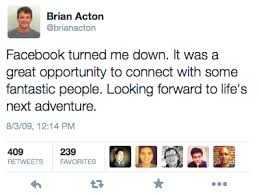À chaque lancement de lunettes connectées, je ressens toujours ce frisson de curiosité technologique, ce petit effet « Wahouh »…suivi d’un soupçon…
Voilà ce matin que le géant Facebook annonce une acquisition de plus de 16 Milliards de dollars.. WHATSAPP, l’application de messagerie instantanée la plus populaire au monde.
- 450 millions d’utilisateurs actifs,
- 19 milliards de messages envoyés chaque jour,
- 34 milliards reçus par jour…
Il faut dire qu’après l’échec cuisant de la tentative de rachat de Snapchat et les annonces de perte d’audience, Mark Zuckerberg se devait de faire quelque chose pour rassurer les actionnaires…
Peine perdue puisque le titre perdait 2% hier en bourse en cotation hors séance malgré cette acquisition parmi les plus importantes de l’histoire de la technologie et des applications mobiles.
On se souvient pourtant que Facebook avait déjà fait une belle acquisition en 2012 : Instagram, le réseau photo le plus populaire.
Instagram..racheté pour 1 milliard de dollars en 2012.. 30 millions d’utilisateurs et.. 13 employés !!!!
La même année le géant de la photographie, KODAK, avec plus de 145 000 employés faisait faillite…
C’est ce que rappelle très bien Angella Nazarian dans son dernier article dans le Huffington Post « The Technology Revolution and Its Role in Our Lives » , expliquant que le monde a changé et que les métiers aussi changent.
« AVEC LE DIGITAL NOUS CHANGEONS DE METIER »
C’est ce que dit Cris Viehbacher, Directeur Général de Sanofi, aussi dans sa dernière interview à BFM Business que je vous invite à regarder si vous ne l’avez pas encore fait.
Elle fera du bien à tous ceux qui sont convaincus que les changements sont en route et que la pharma doit évoluer.
Dans cette interview, Cris Viehbacher reconnait être parti avec 50 cadres à la Silicon Valley pour découvrir les startups en E-santé. (tiens ça me rappelle quelque chose )
Il était temps de s’intéresser au digital…et plus largement à la E santé.
PMLIVE nous le rappelle aussi cette semaine ; 2014 c’est l’année ou les médecins « digital native » deviendront majoritaires.
Les enjeux sont donc majeurs au confluent des changements démographiques, économiques, sociétaux qui impactent la santé.
C’est ce que reprend le « Digital Health Manifesto » de Nuviun que je vous invite à lire … je le trouve très pertinent.
Mais comment faire ??
Comment arriver à impulser l’innovation et aller dans ce sens ?
Nous avions déjà abordé cette question dans une précédente tribune « Pharma, libère tes talents ».
Cette question est très bien abordée dans l’article de Deidre Coleman cette semaine pour EyeforPharma : The DNA of Disruptive Innovators: Will Pharma be Disruptors or Disrupted?
J’invite tous les décideurs de l’industrie à lire cet article.
Non seulement pour les 5 compétences qui sont mises en avant pour favoriser l’innovation au sein des organisations mais aussi pour les messages forts qui sont passés.
This is something pharma probably hasn’t even considered, but their biggest threat might come from outside of pharma, from technology suppliers keen to enter into the healthcare space
Alors oui, Sanofi est en train de changer de métier ; le lancement de l’IBG Star, sa présence dans plusieurs pilotes de télémédecine ou au sein de l’incubateur de E-santé Paris incubateur et plus simplement le fait d’avoir créé une division en charge de la E santé dans son organisation sont révélateurs de ce changement.
Mais combien de laboratoires peuvent en dire autant?
Le simple argument économique ne peut suffire à expliquer ce conservatisme.
Sans minimiser les difficultés de cette industrie, c’est peut être maintenant alors qu’il faut investir sur l’innovation tant qu’il en est encore temps ?
Je conclurais sur un clin d’œil……regardez ce tweet :
Brian Acton, fondateur de WHATSAPP qui vient de toucher 16 milliards de dollars ce matin, s’était vu refuser un poste chez Facebook en 2009 en se demandant ce qu’il allait bien pouvoir faire….
Comme quoi… TOUT EST POSSIBLE !
Digitalement vôtre
Le Pharmageek pour Le Club Digital Santé





